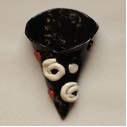
LESSON PRESENTATION INSTRUCTIONS
FORM
CERAMIC VASE WITH ADD-ONS
Lesson Objectives: Students will create a clay vase using the slab and scoring technique to add-on clay designs.
Time Required: 2 sessions, 1 hour each
Artist: Edgar Degas, The Little Dancer of 14 Years, after 1922 (available online)

Materials, Session 1:
Clay
Paper bag or cardboard placemats
Small cups or lids of water
Rolling pins
Clay tools and/or toothpicks
Materials, Session 2:
Glaze
Paintbrushes
Dixie cups
Presentation:
Discuss slab and scoring techniques. Discuss form.
Procedure, Session 1:
- Demonstrate how to make a slab using a rolling pin. Rotate direction of rolling pin to create an even slab. Occasionally lift and flip clay so it doesn’t stick to the paper.
- Roll a slab large enough to fit the circle template. Trace and cut around circle.
- Score the sides and edges of the circle, wet with a fingertip to create a slip (glue) and fold over to make a cone shape, leaving the inside hollow. Smooth the joined edges.
- Using the remainder of their clay, build features to add on to the vase as decorations. Shapes and coils can be used. Pieces must be joined well or they will fall off when the clay dries. It’s easier to place one hand gently inside the cone to support the clay when you add on a piece.
- Clay can be added on in a random/abstract design, or a scene of some sort can be made: a face, a landscape, etc.
- Poke 2 holes in the top of the vase for a ribbon hanger.
- Sign the artwork on the back with a toothpick. Suggest initials and year.
- Let dry for 14 days. Bisque fire in the kiln.
Procedure, Session 2:
- Masks should be glazed with 2-3 coats of glaze.
- Don’t get glaze on the bottom! Or use stilts in the kiln so the glaze doesn’t come in contact with the kiln shelf.
- Let dry overnight and glaze fire in the kiln.
- Attach a ribbon to the vase through the holes for hanging.

